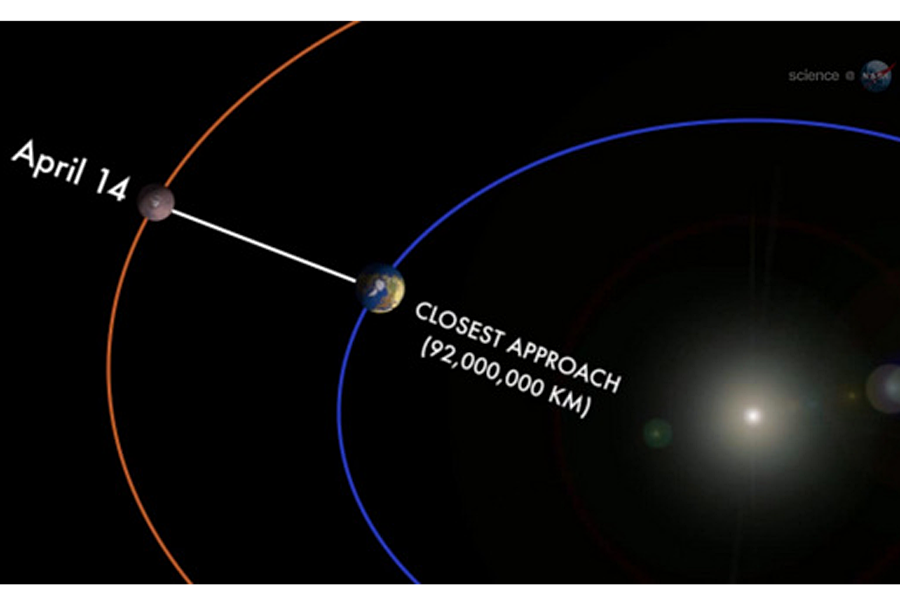Mars to come so close to Earth you could almost touch it
Loading...
A huge night for stargazers is nearly here: On Monday evening (April 14), Mars will make its closest approach to Earth in six years, just ahead of a total eclipse of the moon.
Mars will be at its closest to Earth since 2008 when the Red Planet comes within 57.4 million miles (92.4 million km) of our planet. While that close approach occurs during the daytime, at 8:53 a.m. EDT (1253 GMT), Mars will rise later in the southeastern night sky and shine throughout Monday evening as a sort of night sky preview for the first total lunar eclipse of 2014 early Tuesday (April 15).
You can watch live webcasts of Mars and the total lunar eclipse on Space.com, courtesy of the Slooh community telescope, NASA and the Virtual Telescope project. The Slooh Mars webcast will begin at 10 p.m. EDT (0200 April 15 GMT), with several lunar eclipse webcasts following at 2 a.m. EDT (0500 GMT) on Tuesday.
Editor's Note: If you snap an amazing picture of Mars or the total lunar eclipse, you can send photos, comments and your name and location to managing editor Tariq Malik at spacephotos@space.com.
How to see Mars at its best
On April 8, Mars was at opposition to the sun, meaning it was on the opposite side of Earth from the sun — a celestial alignment that occurs every 26 months. The past several years have been lean ones for Mars observers.
Those who witnessed its spectacular 2003 Mars approach, which brought the planet within 34.6 million miles (55.7 million km) of Earth, have had to settle for increasingly poorer views of the Red Planet as the Earth-Mars orbital geometry became more unfavorable. But that trend is ending with Monday's event, Mars will make its closest approach to Earth since Jan. 3, 2008.
And yet, despite the improvement, this is still below-average in terms of favorability. Currently, a 6-inch telescope with an eyepiece magnifying 118-power will show Mars' rust-hued disk appearing as large as the full moon appears with the unaided eye and yielding detail only grudgingly. Even so, observers may be able to spot new features in the light and dark markings that cover the planet's surface.
On Monday at 2 p.m. EDT (11 a.m. PDT/1800 GMT), the moon will pass 3 degrees south of Mars, an invisible event because the Americas will be in daylight and the moon and Mars will be below our horizon. When they first appear in the east-southeast sky later that evening, they will have noticeably separated; the moon having moved on to the east, closer to Spica en route to its rendezvous with the Earth’s shadow.
Finally, at 8:45 p.m. local daylight time, compare Mars with the brightest star in the sky — the bluish Sirius (in the south-southwest) — when they stand at equal altitudes. The Observer's Handbook of the Royal Astronomical Society of Canada says both will shine at the same brightness, a magnitude -1.5. Which do you think appears brighter?
Mars would likely garner most, if not all, of the attention on Monday night if it were not for the total lunar eclipse following soon afterward. But the Red Planet's close proximity to the soon-to-be-darkened moon will no doubt have not a few people asking the question: "Just what is that fiery-colored object that’s glowing high above the moon?" So at least in a literal sense, Mars will "top" the moon on Monday evening.
Total lunar eclipse could wow U.S.
Mars aside, the moon is poised to wow observers across most of North America with it is eclipsed by Earth's shadow between 2 a.m. EDT and 5 a.m. EDT (0600 to 0900 GMT) on Tuesday morning. [Total Lunar Eclipse of 2015: Complete Coverage]
Those in the eastern states will have this shady little drama take place between midnight and dawn, while those out based on the U.S. West Coast, in Alaska and Hawaii will see it in the middle of the night. Regardless, many stargazers will be out Monday evening to admire the full moon as it rises over the east-southeast horizon soon after sunset.
There is also religious significance in that this is also the Paschal Full Moon. Simply speaking, the Paschal Full Moon is the first full moon after the spring equinox. This moon sometimes occurs in March and sometimes in April.
The word Paschal means "Passover" in Greek (a transliteration of the Hebrew word "pesach"). Indeed, Monday evening marks the start of Passover. Monday's full moon is also significant because it is used to determine what date Easter will fall on each year. This is why Easter is a movable holiday, occurring anytime from March 22 to April 25.
Besides the moon and Mars, one other objects are likely to attract some attention. Just below the moon there will be a star shining with a bluish tinge. That will be Spica, the brightest star in the constellation Virgo.
While the moon might seem to overwhelm Spica with its brilliant light early Monday evening, it will be a different story some hours later when the moon is completely immersed in the Earth’s shadow and appears 10,000 to 100,000 times dimmer. Then Spica will stand out like a bluish jewel next to the dull ruddy ball of the totally eclipsed moon.
Joe Rao serves as an instructor and guest lecturer at New York's Hayden Planetarium. He writes about astronomy for Natural History magazine, the Farmer's Almanac and other publications, and he is also an on-camera meteorologist for News 12 Westchester, N.Y.Follow us @Spacedotcom, Facebook and Google+. Original article on Space.com.
- Close Mars, Lunar Eclipse And Lyrid Meteors - April 2014 Skywatching Video
- Mars Coming Close: Where To Look | Video
- Spectacular Night Sky Photos for April 2014 (Stargazing Gallery)
- Best Beginner Astrophotography Telescopes
Copyright 2014 SPACE.com, a TechMediaNetwork company. All rights reserved. This material may not be published, broadcast, rewritten or redistributed.







